Leadoo Academy Certification
Conversion Rate Fundamentals
This certification is for marketing and sales professionals who want to show the value of their work and exceed their goals. Get ready to master conversion fundamentals and turn your website into a sales engine.
video: ”A word from your coach”
- Hi there, I’m X from Leadoo Marketing Technologies. I will be your coach during this conversion rate fundamentals certification.
- Can I just say that I’m so excited to have you here! It means that you’re not afraid to dig into the results of your marketing activities and learn to become even better at your craft.
- Completing this certification will give you the answer to questions like: What are conversions, conversion rate and CRO, Why are these important, How to measure conversion results, How to get more conversions from your web traffic, and more..
- This certification consists of 5 parts and 2 quizzes. To pass, you will need to score 80% or more in the final assessment
- After passing the final test, you will get a badge that shows your network that you know your stuff when it comes to conversion focused marketing.
- Wear the badge with pride – you can easily add the achievement to your LinkedIn profile.
- I hope you’ll discover lots of useful ideas and tools for improving your conversion results starting today. Good luck!
Completion time: 3-4 hours
5 parts, 2 quizzes, 1 final test
Get a badge on your profile
Content outline
Part 1
Introduction to conversions and conversion rate
Definitions
Conversion is the end goal of your marketing activities and campaigns that drive traffic to your website. A conversion is in essence an action taken by a website visitor. Conversions come in many forms, but they are always linked to a business goal.
Conversion rate is a metric that tells the percentage of website or landing page visitors that completed a conversion. The generic formula for calculating conversion rate is: #conversions / #visitors * 100%.
CRO or conversion rate optimization is the practice of improving a conversion rate. CRO is a continuous effort of experimenting with and finding ways to improve a website or landing page’s ability to convert visitors into leads and customers.

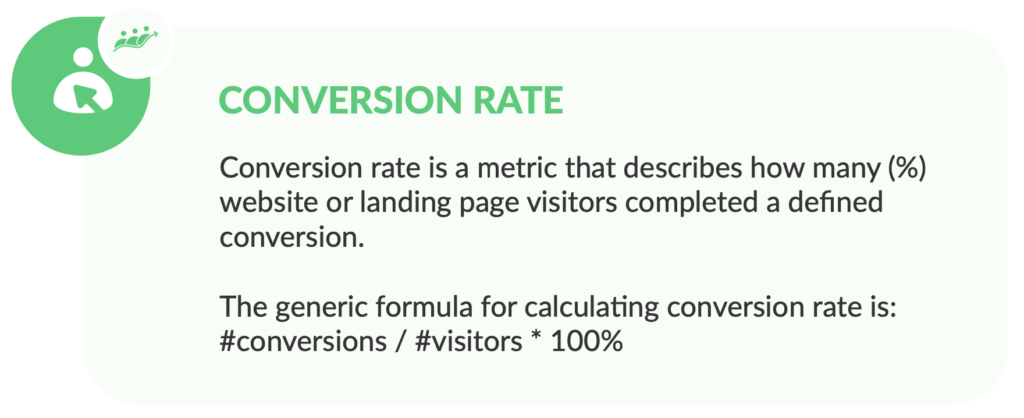
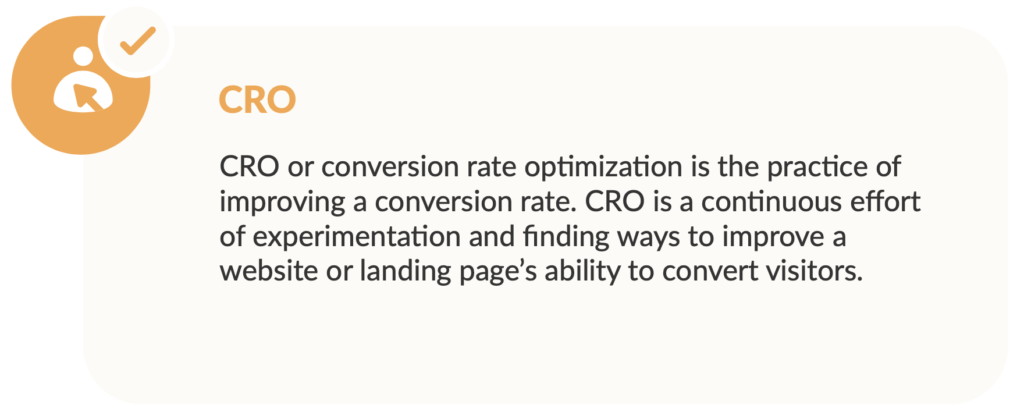
video: ”Conversions, conversion rate and CRO in a nutshell”
- For years, marketers thought that the best way to get results from a website is to drive more traffic to the site.
It’s about time to accept that focusing on conversions – rather than traffic – is by far the most powerful and cost-effective way to generate leads and sales from the website. - Tiny improvements in conversion rate can turn into massive incremental revenue. And the best thing about it? That revenue comes from the traffic and demand you already have.
- Simply put, a conversion is an action taken by a website visitor that is linked to one or more business goals.
- Conversion rate is a metric that tells the percentage of website or landing page visitors that completed a conversion.
- Conversion rate optimization or CRO is the practice of improving conversion rates by methods of experimentation.
- Conversion is the end goal of marketing activities and campaigns, and ultimately, conversions tell how successful or unsuccessful your marketing efforts really are.
- Without clear visibility to conversions, marketing will be largely based on hunches about what works and what doesn’t. That is obviously not the optimal way to do marketing.
The role of conversions in marketing and business
Conversions tell you (concretely) how well your marketing is performing. Each marketing activity or campaign should have an end goal, for example generating demand and capturing it as demo requests. Therefore, conversions are one critical metric to determine your campaigns’ success.
You should also consider the importance of conversions in a broader sense.
Before people in your audience convert, they are unidentified and cannot be linked to any specific information, interest or other traits. The point of conversion changes the relationship between you and the person. As they walk through the conversion gate, you are often rewarded with their contact information and/or other valuable insights.
Conversions give you information about buyers and help you to move the potential customer forward on the buyer’s journey. Especially when treated as leads, converted people feed the work of sales, securing your future pipeline and revenue.
To put it short and sweet: conversions are good and you want more of them.
Reasons to care about conversion rate
Conversion rate matters because it largely defines the success of your marketing activities. With a low conversion rate, much of the effort you put into campaigns will go to waste.
If you don’t know your conversion rate, your marketing will be based on hunches about what works and what doesn’t. And that.. Well, it obviously isn’t the optimal way to do marketing.
video: ”Why conversion rate matters”
- So, conversions define a big part of the success of your marketing activities.
- With a low conversion rate, much of the effort you put into campaigns will go to waste. You may get a lot of people on your website, but most of them will not take the next step towards becoming a customer or building a relationship with your business.
- But what if you could find a way to improve the conversion rate?
- When conversion rate is on a good level, it will make more sense to drive traffic to the website. You will be better equipped to capture existing demand and turn it into sales and revenue.
- The beauty of conversion rate and CRO is, that the starting point doesn’t matter. A conversion focus helps you to squeeze more results from the traffic and interest that’s already there.
- Even better, conversion rate improvements increase the effectiveness of current and future campaigns.
- These reasons should be enough to make you wanna rethink how you prioritize web traffic and conversions.
Improvements in conversion rate increase results from all of your marketing activities. There are two ways to consider conversions and how to get more of them. You can either:
• Drive more traffic to your website, and at some point you should see more conversions
• Focus on improving the website’s conversion performance for existing traffic, and increase results for current and future campaigsn
The first option is simple. You can always pour more money into ads and get more traffic. But this is expensive and doesn’t guarantee results. Much of your effort will still go to waste, and you haven’t done anything to learn more about your customers or to provide a better experience.
The second option has obvious pros. With a better conversion rate, it makes more sense to drive traffic to the site. The beauty of conversion rate optimization (CRO) is that the starting point doesn’t really matter – you’re squeezing out better results from the traffic and interest that already exists.
Key takeaways
- A conversion is an action taken by a website visitor that is linked to a business outcome or goal
- Conversions fuel marketing, sales and growth
- Conversion rate measures the effectiveness of a website – it is a much more concrete and valuable metric compared to web traffic
- Improvements to conversion rate increase the effectiveness of all marketing activities and campaigns
Useful resources
What is Conversion, Conversion Rate and CRO?
Complete Guide to Conversion Rate and CRO
Conversion Rate Fundamentals for Marketers (pdf guide)
Part 2
Conversion types and how to use them
Different conversion types for different goals
So, conversions are actions that people (potential and existing customers) take on your website. From the list below, you can see that some conversions are directly linked to revenue, whereas others are further up the funnel.
In both cases, the purpose of a conversion is to nudge the person closer to becoming a customer, or to strengthen the relationship between them and your business.
Here’s a list of common conversion types:
- Request for quotation
- Contact request
- Demo request
- Purchase and order
- Content download
- Form submission
- Newsletter subscription
- Event and webinar sign up
- CTA click
- Call and email
Not all prospects are equally ready to buy. That’s why it makes sense to provide multiple conversion types that require a different level of commitment.
Whilst conversions are often only considered part of marketing and sales, they are equally important in terms of recruitment and customer service.
When hiring, you need to convert job candidates much like you would MQLs or SQLs. In this case, conversion means a sent application or other indication that the candidate is interested in joining your team.
In customer service, conversions can be thought of as incoming requests and resolved issues. It may seem far-fetched to call these conversions, but think of it this way: if your customer has an issue and is unable to reach you via the website, it’s unlikely that they will keep being a customer for very long.
video: ”Common conversion types and when to use them”
- A conversion is in a way what you make it.
- Different conversion types are used for activating prospects and customers in different stages of the buyer’s journey.
- As a recap, the buyer’s journey consists of 3 stages: Awareness, Consideration, and Decision. From the traditional marketing funnel perspective, these stages roughly represent top of the funnel, middle of the funnel, and bottom of the funnel, respectively.
- The website visitors’ readiness to buy differs by funnel stage. Some are more educated and prepared to make a decision than others.
- By providing different conversion opportunities, a business can capture more of the interest that exists on different levels.
- Commonly used conversion types include contact and quotation request, purchase and order, content download, newsletter subscription, chatbot conversation and form submission, event sign up, CTA click and so on.
- The key to selecting and using different conversion types is to know what drives your target audience, and how they progress in the buyer’s journey.

Regarding marketing and sales conversions, different conversion types can be mapped onto the buyer’s journey funnel.
Roughly speaking, the buyer’s journey consists of three stages:
- Awareness
- Consideration
- Decision
As prospects and customers move through these stages, their commitment level increases and that is reflected in the types of conversions that are likely to occur.
Looking at conversion types from the funnel perspective provides an idea of what activations work for customers in different stages. In reality, buyer’s journeys are rarely exactly direct. This means that a customer may revisit earlier stages and therefore someone already in the decision stage may complete a more top of the funnel conversion.

Top of the funnel conversions
video: ”What are top of the funnel conversions”
- What is meant by top of the funnel (awareness stage)
- conversion type examples
- the purpose of these conversions
Typical top of the funnel (awareness stage) conversions include:
- Landing page visit
- Click on a CTA
- Webinar sign up
- Content download
- Newsletter subscription
Awareness stage conversions capture the interest that is forming towards an idea or a solution. These conversions are important in that they ”pull” new people into the funnel.
Top of the funnel conversions can provide valuable signals about latent interest, and may help identify future opportunities. However, it would be unwise to approach people in the awareness stage with a heavy sales focus, as most of them are not ready to buy.
Middle of the funnel conversions
video: ”What are middle of the funnel conversions”
- What is meant by middle of the funnel (consideration stage)
- conversion type examples
- the purpose of these conversions
Typical middle of the funnel (consideration stage) conversions include:
- Newsletter subscription
- Content download
- Contact request
- Chatbot conversation
- Form submission
- Demo request
- Email or call
Middle of the funnel conversions are the most versatile bunch, and drawing a line between the stages here is practically impossible.
At this stage, people in the funnel are more aware of their problem and potential solutions to it. Conversions signal that the potential buyer considers the particular vendor or solution as an alternative.
This stage involves higher commitment, as most of the conversion types include sending over personal contact information and other details.
Bottom of the funnel conversions
video: ”What are bottom of the funnel conversions”
- What is meant by bottom of the funnel (decision stage)
- conversion type examples
- the purpose of these conversions
Typical bottom of the funnel (decision stage) conversions include:
- Demo request
- Email or call
- Calendar booking
- Request for quotation
- Purchase or order
Decision stage conversions are what you should ultimately aim for. Awareness and consideration drive people to the bottom of the funnel, where they have a decision to make: Do I want to do business with this company or not?
Bottom of the funnel conversions capture strong purchase intent and actual transactions. In all cases, they are closely linked to results and revenue.
Key takeaways
At all times, your audience includes people in different stages of the buyer’s journey. In other words, their readiness to buy varies.
By providing alternative ways to convert, you can make sure that people in all three stages have natural and appealing opportunities to move forward.
You should match your follow-up and sales approach with the specific buyer’s journey stage as accurately as possible.
Some conversion types may be triggered by prospects in more than one buyer’s journey stage.
Useful resources
What Is the Buyer’s Journey? (HubSpot blog)
Quiz 1
Part 3
KPIs – How to measure conversion results
The importance of measuring conversion results
There’s no point in doing conversion rate optimization, unless you’re able to measure the results. The need to track conversion performance should be a no-brainer. It’s the only way to know whether what you’re doing is bringing in any value.
In this part, you’ll be introduced to a set of useful conversion KPIs and learn how to work with them.
Conversion KPIs – What you can and should measure
video: ”Introduction to conversion KPIs”
- Conversions are a classic case of ”If you can’t measure it, you can’t improve it.”
- It really pays off to keep track of your conversion results. That’s the only way you’ll know whether your marketing efforts bring concrete results, and how you’re able to improve your game over time.
- There are a number of conversion-related KPIs that inform you about how your campaigns and projects are translating into numbers, and ultimately, revenue.
- Depending on your operations, resources and available data, you want to choose the most relevant KPIs to track.
- In our experience, the most useful conversion KPIs include the following
- Total number of conversions: This says a lot about your marketing performance. With several conversion types, it makes sense to track the number by conversion type.
- Conversion rate: This tells you how many of your website visitors you’re able to nudge forward on their buyer’s journey.
- Cost-per-acquisition or CPA: In this context, CPA practically means cost per conversion – how much are you paying for each conversion or lead.
- Conversion value: the opposite of CPA – what is a conversion worth to your business.
- ROI and ROAS: CPA and conversion value put together provide an estimate of return-on-investment or return-on-ad-spend. This KPI says whether you should continue doing something or cut it.
- Sales funnel metrics: KPIs like average deal/purchase value and lead-to-customer rate help you estimate marketing results more accurately.
- Revenue: the end goal of your conversion efforts is to generate revenue. Measuring the bottom-line impact is extremely important when you want to show the value of marketing.
- You don’t need to know all of these KPIs by heart. Start by figuring out your current level on the most relevant KPIs, and use it as a benchmark for future.
Total number of conversions
The number of conversions is your most basic conversion KPI. Especially if you’re only collecting one or two conversion types, tracking this number alone will say a lot about your performance.
By knowing how many conversions you were able to capture in a week or a month, it’s easy to reflect the performance with your marketing activities from that period.
Perhaps that increase in PPC ad spend brought you significantly more conversions? Or maybe it was your new landing page design?
If you’re collecting several different conversion types (for example: quotation requests, demo bookings, event sign ups and newsletter subscriptions) it makes sense to track the number of conversions by type.
Tracking conversions by type helps you see what areas in your marketing need more attention.
PRO TIP
Tracking conversions by type helps you see what areas in your marketing need more attention.
Conversion rate
Conversion rate is the percentage of website visitors who completed a conversion. In all simplicity, you calculate conversion rate by dividing the number of conversions with the number of visitors.
Conversion rate = #CONVERSIONS / #VISITORS * 100%

video: ”Conversion rate explained”
- (similar video can be done for other KPIs, too)
This central KPI measures the performance of your campaigns and landing pages. You can calculate conversion rate for an entire domain or selected pages. For more detailed insights, you can analyze conversion rates for specific channels or campaigns.
We’ve listed some recent conversion rate benchmarks in this article.
PRO TIP
For more detailed insights, you can analyze conversion rate for a specific channel or campaign.
Cost per acquisition (CPA)
Another important conversion KPI is CPA, or cost per acquisition. In this context, CPA essentially means cost per conversion. That is, how much you paid for a conversion.
Conversion CPA is calculated by dividing the associated marketing costs with the number of conversions:
CPA (for conversions) = ASSOCIATED MARKETING COSTS / #CONVERSIONS

PRO TIP
For more accuracy, consider also indirect marketing costs in the CPA calculation.
In many cases, it’s good enough to only include directly attributable costs, like ad spend for a specific campaign. For increased accuracy, you’ll want to add up all associated costs in the formula.
Example: You spent 1650€ on a Facebook campaign and 1200€ on PPC advertising on Google. These activities promoted an offer for visitors who could convert by sending their information through a landing page. The campaign resulted in 75 conversions (leads).
Your CPA for this campaign, considering only ad spend, is: (1650 + 1200) / 75 = 38€
In other words, you paid 38€ for each conversion.
Conversion value
The natural next step from knowing the cost of a conversion is to find out the value of a conversion. As a KPI, conversion value helps you to estimate the ROI of CRO activities and marketing in general.
Conversion value is always based on estimates, except for when the conversion is a purchase, in which case conversion value can be considered equal to purchase value.
PRO TIP
One transaction does not always cover the entire value of a conversion. Use long-term value metrics (like LTV) for a more realistic estimate.
In other cases, you will need to rely on your knowledge and data about funnel metrics. Specifically, you’re interested in the likelihood of the conversion turning into a transaction, and what the value of that transaction will be.
As metrics, these could be your lead-to-customer conversion rate and average deal size. The sales team should have a good understanding of these values.
Often, one transaction doesn’t cover the entire value potential of a conversion. Therefore, it may be necessary to link conversion value to customer lifetime value (LTV or CLV) or other long-term value metrics.
Conversion ROI / ROAS
Return on investment should be a key interest to marketers in all situations. When you know the number of conversions, cost per conversion, and conversion value, you can calculate your ROI for the actions you took with a conversion goal in mind.
For a basic conversion ROI formula, you need to know:
- The total number of conversions
- The value of conversions (#conversions * conversion value)
- The cost of conversions (#conversions * CPA)
You can then calculate conversion ROI as follows:
ROI = (VALUE OF CONVERSIONS – COST OF CONVERSIONS) / COST OF CONVERSIONS * 100%

PRO TIP
Be mindful about indirect costs in ROI calculations. By omitting them, your ROI will seem higher than it really is.
Example: Let’s assume that in the CPA example above, conversion value is estimated at 160€. In that case:
Value of conversions: 75 * 160€ = 12 000€
Cost of conversions: 75 * 38€ = 2 850€
ROI: (12 000 – 2 850) / 2 850 * 100% = 321%
ROI of 321% means that the conversions returned more than 4x the associated marketing investment.
Note that omitting indirect costs results in higher ROI than what the reality is. In this example, ad spend was the only cost taken into account, but obviously, running a conversion campaign incurs also costs as salaries, software fees, and time spent working on the campaign.
Adding these expenses to the cost variable would drag the ROI down, but the campaign would still remain profitable.
Return on ad spend (ROAS) is comparable to ROI, but it only reflects campaign results with ad spend. ROAS is a simple KPI, because you only need to account for ad spend and not worry about indirect costs.
Sales funnel metrics
To discover the truth about your conversion performance, you need to go beyond website conversions.
If you think about it, conversions may include fluff that never turns into business. Hence, it’s important to follow up on conversions over to the sales side. How do the conversions you capture proceed in the sales funnel, and what are they worth?
Collaborate with sales to define your lead-to-customer conversion rate. That is, at what percentage do leads (conversions) turn into paying customers. The other side of it is expected revenue generated from those customers. For this, you can simply use average deal size.
Remember, though, to account for variation in deal value. For instance, deals that originate from outbound sales could have a higher average value than deals that originate from online marketing activities and website conversions.
PRO TIP
Take into account variation in deal value. Conversions from different sources and campaigns don’t always have equal value potential.
Revenue
At the end of the day, you’re converting people to generate revenue. If the KPIs listed above are looking bright, it’s likely that your conversion efforts are doing a handsome contribution to overall revenue.
On the other hand, you could be dissatisfied with marketing generated revenue. In that case (at the latest), it’s a good idea to dig into the data and calculate a benchmark for these conversion KPIs.
A benchmark that’s based on your company’s historical performance is always the best starting point when your goal is to increase conversion results.
PRO TIP
Whichever KPIs you choose to use, try to always have visibility to how they affect actual sales and revenue.
Key takeaways
Conversion performance can be measured for an entire website and all conversions. For more accuracy, you may want to track conversion performance by conversion type, campaign or channel.
Conversion KPIs include:
- Number of conversions
- Conversion rate
- CPA (cost per acquisition)
- Conversion value
- Conversion ROI
- Sales funnel metrics
- Revenue
You don’t need to know the exact value of each KPI. An estimate is usually enough, because it will give you a benchmark to reflect your performance with. A benchmark from your own business is the best starting point for conversion rate optimization (CRO).
Useful resources
Conversion KPIs – How to Measure Conversion Performance
Part 4
Conversion rate optimization fundamentals
What is conversion rate optimization and who is it for?
Conversion rate optimization or CRO is the practice of improving a website’s conversion rate. CRO is a continuous effort of experimenting with and finding ways to improve a website or landing page’s ability to convert visitors into leads and customers.
CRO is for all companies that wish to support sales and generate concrete results from their website. A common misconception is, that CRO is only for ecommerce. As you know by now, a conversion can be many other things besides a purchase from an online store.
Especially in B2B, even top of the funnel conversions can play a huge role in securing future pipeline. And most B2B companies can still capture hard conversions like quotation requests on the side. CRO really is for every company that has a website with decent traffic.
video: ”Introduction to CRO: what is it, how is it done, and why does it matter?”
- Conversion rate optimization or CRO is the practice of improving a website or landing page’s conversion rate.
- CRO is about running experiments whose goal is to discover more effective ways to activate and convert website visitors.
- A common misconception is, that CRO is only about tweaking button colors and CTA copy on e-commerce websites.
- In reality, all companies with a website and a decent amount of traffic can benefit from CRO.
- At best, CRO helps businesses acquire more new customers and lower customer acquisition costs. It is a cost-effective alternative to simply acquiring more web traffic, which has no guarantee of turning into concrete results.
- A CRO experiment can target several variables, including landing page layout and content, CTA style and placement, chatbot and contact form structure, design elements and so on.
- Conversion insights can be discovered with different testing methods. The most common include A/B-testing, A/B/n-testing, multivariate testing and user testing.
- Each experiment should follow a structured process. This helps in finding confident evidence of a change’s positive, neutral or negative impact on conversion rate.
Why CRO is important
Investing in conversions, conversion rate, and CRO is a great idea, because the work you put in directly targets the low-hanging fruits. Think of it this way: there are basically two options to growing your business online
- Pouring more money into traffic acquisition: this is expensive, takes a lot of work, and the results can be difficult to quantify
- Focusing on the traffic you already have (CRO): this is a cost-effective strategy, small changes can have a huge impact, and the results are easy to validate
Naturally, you need both.
But when looking to get quick and measurable results, investing in CRO is your best bet. As a bonus, all the work you put in will improve your online customer experience.
It pays off to put efforts into CRO for two important reasons:
1) CRO helps you to acquire more new customers
Conversion rate optimization essentially improves your chances of converting a new visitor. The beauty of it is that CRO brings results regardless of much traffic you have. All of those people come to your website for a reason, and you want to provide natural points of conversion to as many as you can.
2) CRO helps you to lower customer acquisition costs
Better conversion rate means that your marketing activities will have a higher ROI. Every coin you spend on advertising, SEO, and so on, will be used more effectively with a high conversion rate. As a result, you can even cut down your advertising budget – or at least your ROAS (return on ad spend) will improve. In the bigger picture, these improvements are reflected in your CAC (customer acquisition cost).
Here’s a simple illustration of how an increase in conversion rate can bring greater results even when everything else remains untouched.
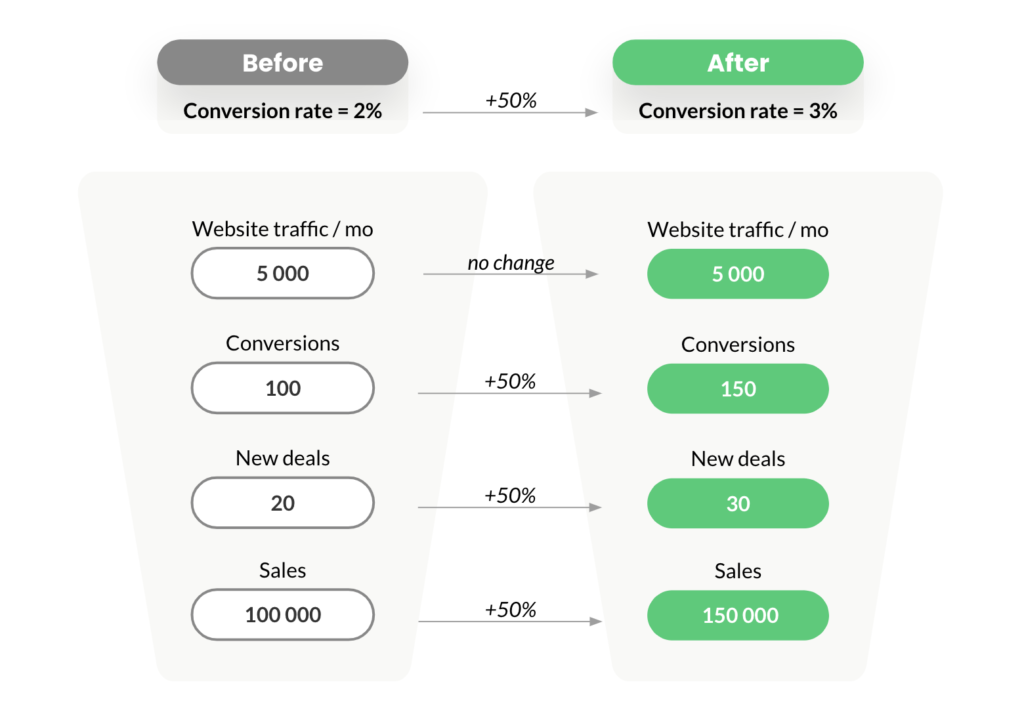
What should you optimize for?
What conversions are you looking to capture? What’s the business context, and where are your worst bottlenecks? Who are you targeting?
Answers to these questions will guide your conversion efforts. Generally speaking, there are a few different conversion categories you can focus on.
Lead conversion
A lead is someone who has shown interest towards an offering, and may be approached by sales or engaged further with marketing activities. Lead conversion has its place in both B2B and B2C.
Ecommerce
The primary conversion focus of ecommerce players should be on purchases and orders. On top of that, subscriptions to product newsletters and offers are a good way to secure future business.
Recruitment & other
Not all conversions are directly sales related. In recruitment, conversions determine a firm’s ability to acquire new team members. In customer service, conversions often mean resolved issues.
Getting started with CRO
There really isn’t one right way to do CRO. That said, you will want to follow certain guidelines to make sure that:
a) you are optimizing things that matter, and
b) you are able to see if your CRO efforts made a difference.
CRO starts from a problem and a hypothesis. Perhaps you aren’t happy with your conversion rate, or get an idea about a design change that could improve the conversion rate.
Before doing any testing, find out what the current conversion rate is – otherwise you won’t know if your CRO efforts helped or not.
The CRO process
Begin the experimentation by forming a hypothesis about something that could improve the conversion rate. Then, prepare the experiment and publish the change(s) you want to test.
A/B testing is a commonly used CRO method, in which you run two different variations of for instance a landing page (A- and B-version) in parallel. After the test, see which version performed better in terms of conversions.
When running conversion rate experiments, it is usually a good idea to experiment with only one variable at a time. This ensures that you can attribute the changes in conversion rate to that variable.
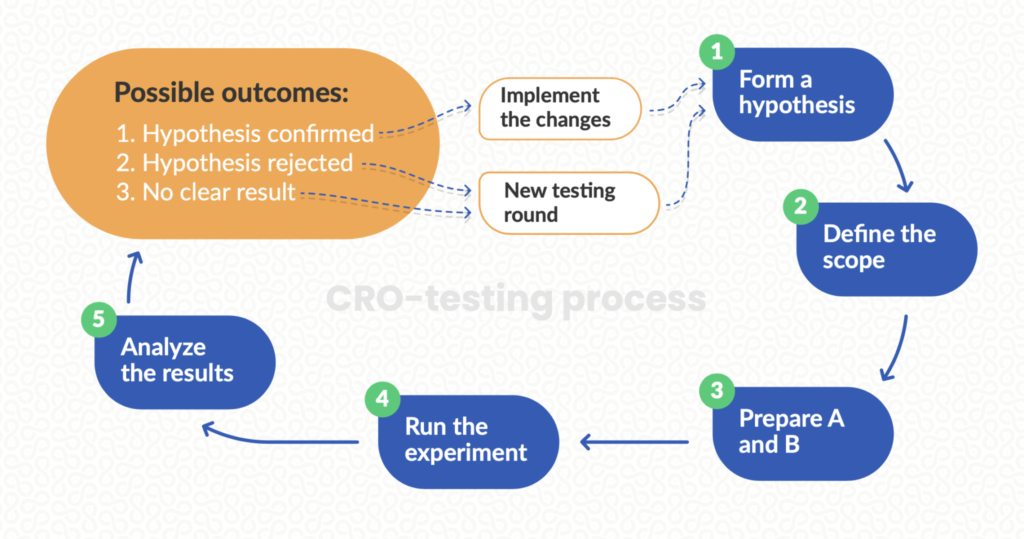
Conversion rate optimization is usually practiced through agile experimentation. Common methods include:
- A/B-testing (or split-testing)
- A/B/n-testing (more than two versions of a variable)
- Multivariate testing (more than one tested variable)
- Usability or user testing
Outline of a CRO-testing process (A/B-test):
- Form a hypothesis about a problem
- Define the scope of the experiment
- Prepare versions A and B
- Run the experiment
- Confirm or reject the hypothesis
- Implement changes and/or test again
What to experiment
Here are a few examples of what you can experiment with to improve conversion rate:
- Landing page layout
- Landing page content
- CTA (call to action) copy, style, placement
- Visual and design elements
- Chatbot conversation
- Contact form fields
Also things outside of the landing page – for example ad copy – affect conversion rate. Such factors affect the expectations of the person who lands on the website, therefore making them either more or less likely to convert.
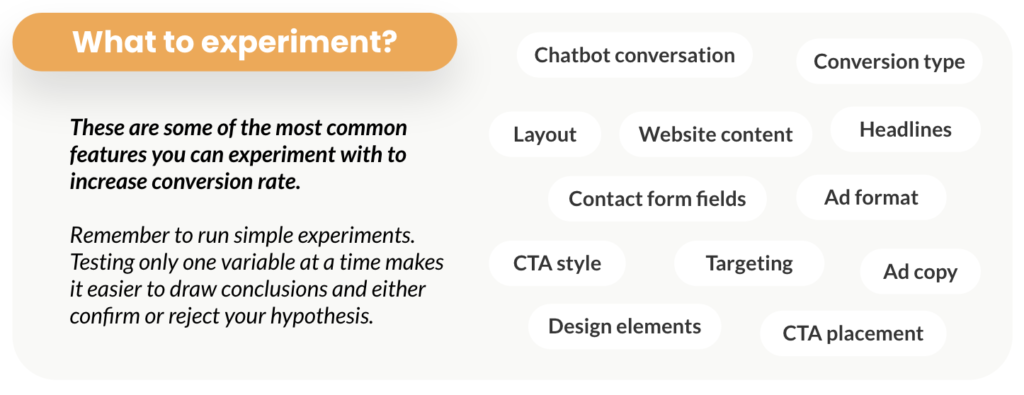
Example: Company A’s previous webinar registration page had a conversion rate of 30%. From 2400 visits, they converted 720 sign ups.
The marketing team hypothesized that edits to the page and chatbot would improve the conversion rate. For the next webinar, they tweaked the layout of the landing page and made it clearer why someone should register. They also simplified the chatbot conversation to make it easier for visitors to convert.
The same amount of visitors landed on the new webinar’s sign up page as previously (2400). However, with the changes made, Company A was able to convert 960 of those visitors. This gives a 40% conversion rate, and a 33% increase in conversion rate compared to the previous webinar.
It should be noted that in this example, other factors outside of the CRO work could have had an impact on the conversion rate. These include f.i. increased trust towards the brand as a result of the previous webinar, and more successful ad targeting.
Nevertheless, examples like this show how small changes can have a big impact and help companies discover untapped conversion potential in their existing web traffic.
Key takeaways
Investing in CRO is a great idea, because the work you put in directly targets the low-hanging fruits. In other words, CRO allows you to get more results from what you already have.
CRO is best done as a systematic process, where it’s important to know the starting point, and to define the scope and method of experimentation.
In essence, conversion efforts and CRO should be focused on three goals:
- Secure a steady (and growing) number of conversions
- Drag CPA as low as possible
- Make conversion value as high as possible
Useful resources
Conversion Rate Optimization Guide (VWO blog)
Quiz 2
Part 5
Tactics & strategies to improve conversion results
You’ve now studied the fundamentals of conversions, conversion rate and CRO.
In this final part of the certification, we’ll pack your bag for a successful conversion journey by busting obsolete conversion myths, pointing out common conversion hazards, and by listing a few select conversion fixes you should give a go.
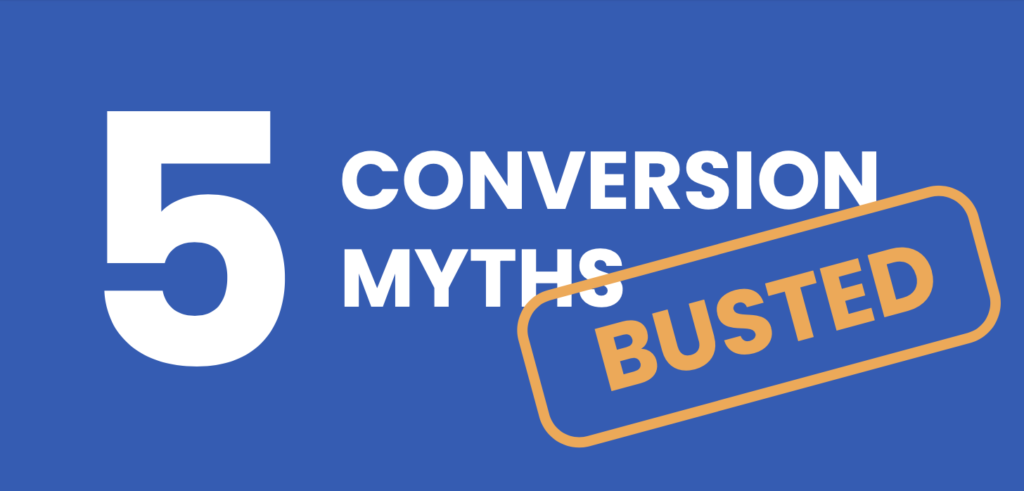
5 conversion myths busted
video: ”5 conversion myths busted”
- Myth 1
- Myth 2
- Myth 3
- Myth 4
- Myth 5
(you can probably use the exact text that is written here)
Myth 1: Conversion rate can be hacked
CRO can bring up powerful tactics and better results quickly. But no trick or hack removes the need to understand your customers and to build your marketing around that knowledge. You can’t succeed if the fundamentals are foggy.
Myth 2: What worked for them will work for you
Not necessarily. Conversions are always highly contextual. Your competitors and benchmark firms have different traffic sources, target audiences, and so on. You cannot know that something will work for you before the results say so.
Myth 3: “People in our industry don’t convert online”
The reason why people don’t convert is that you’re doing it wrong. Don’t get stuck on the old ways: the world changes and your business needs to change with it. There are conversions to be had in every industry. Perhaps it isn’t direct purchases, but something that nudges buyers forward.
Myth 4: “We need more traffic before we can convert”
Conversions deserve attention regardless of web traffic. Sure, more traffic inherently gives you more conversion opportunities. But at what cost? Improvements in conversion rate make all marketing efforts more effective. It’s wise to prioritize the existing potential over pumping money into traffic acquisition.
Myth 5: CRO is all about CTAs and button colors
Unfortunately, this misconception still persists. When done right, CRO is thorough and even scientific work that has implications to marketing on a broader level. The actual tests and tweaks are only a part of it. CRO is a means to achieving better results, but you’ll also learn more about your business and customers.
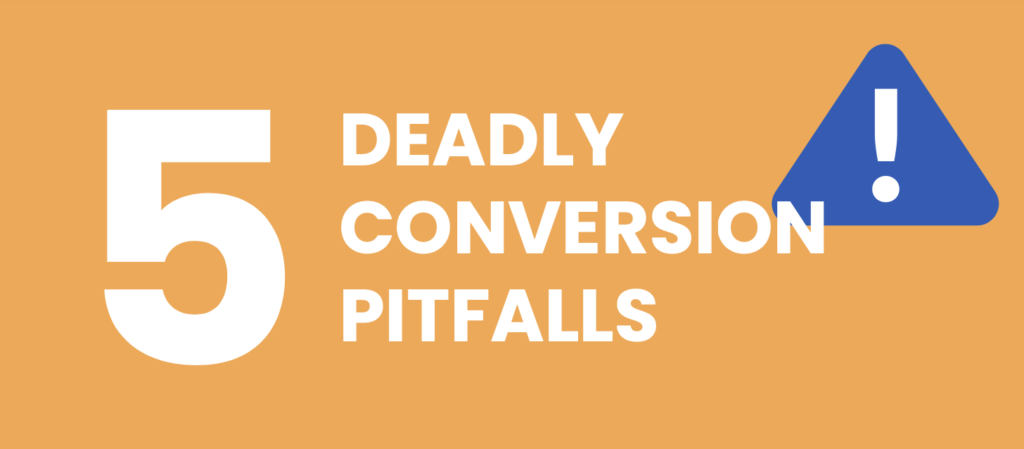
5 conversion pitfalls to avoid
video: ”5 conversion pitfalls to avoid”
- Pitfall 1
- Pitfall 2
- Pitfall 3
- Pitfall 4
- Pitfall 5
(you can probably use the exact text that is written here)
Pitfall 1: Mismatch between marketing & website
Continuity is a basic marketing principle for a reason. If your ads and comms promise different things compared to your website, getting people to convert on the site will be just shy of impossible.
Pitfall 2: Confusing and bad design
Nothing kills conversions like a terrible user experience. Bad design makes converting difficult and causes frustration. Complicated doesn’t mix well with conversion, so make sure you aren’t putting any extra burden on your customers with suboptimal design choices.
Pitfall 3: Poor website performance
Buyers’ patience for slow and unstable websites is at an all time low. Online, every second counts. Poor site performance not only makes it harder to convert, but also crushes customers’ trust in the brand’s ability to deliver what they promise.
Pitfall 4: No customer support or help available
It’s your job to provide customers the answers they need in each stage of the buyer’s journey. And if you don’t? People drop off and you can say goodbye to another conversion opportunity. Make yourself available and approachable to customers, and follow up on contacts quickly.
Pitfall 5: The final conversion hoop is too tight
Finally, it all comes down to the moment of conversion. So many customers are lost here. In B2B, a long and ambiguous contact form can kill the case. In ecommerce, a defective order process may throw a customer directly to a competitor. Build your processes with the customer in mind, and you can avoid this happening to you.
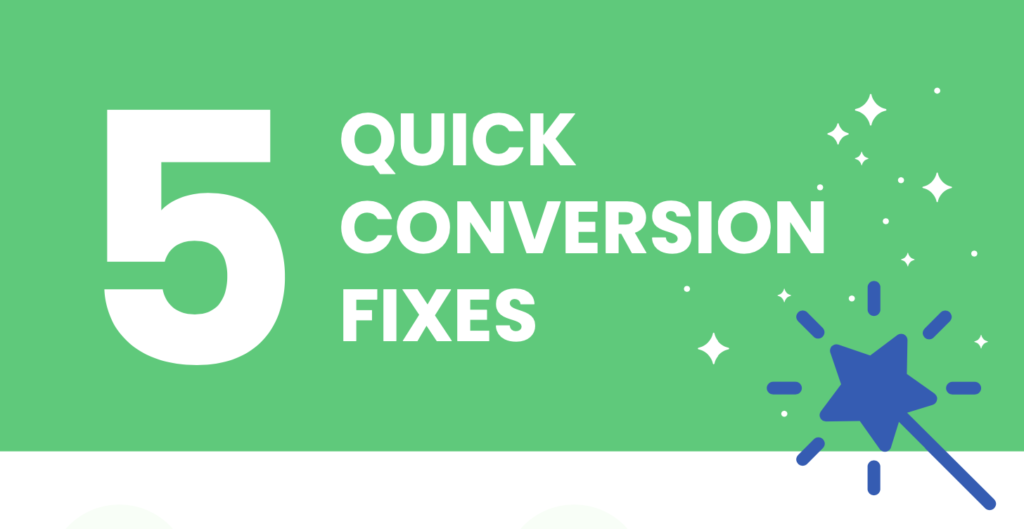
5 conversion fixes to start with
video: ”5 conversion fixes”
- Fix 1
- Fix 2
- Fix 3
- Fix 4
- Fix 5
(you can probably use the exact text that is written here)
Fix 1: Increase the number of conversion points
You shouldn’t bombard visitors with distractive CTAs, but you do want to make sure that a natural conversion point is never more than one click away. A lot of conversions can be gained by simply adding easy and visible opportunities for conversion.
Fix 2: Simplify your designs and messaging
Marketers tend to over explain. When your goal is to convert, you should focus your approach on what information the buyer actually needs to move forwards. Be crystal clear about what you’re offering, and why (and how) the customer should take action now.
Fix 3: Activate visitors by starting conversations
The problem with many conversion methods (incl. most forms and pop-ups) is that they are unidirectional and don’t create real engagement. Conversations with e.g. chatbots activate users naturally and flow towards conversion on the user’s terms.
Fix 4: Shorten the path to conversion
As we’ve established, complication and confusion kill conversions. Think about how many steps and actions website visitors need to go through to complete a conversion. Then, see how you could cut the path into half.. Even removing just one step could have a massive impact.
Fix 5: Test and optimize the conversion funnel
Finally, an effort that’s too easy to forget. The last thing you want is people converting but then dropping out due to a glitch in your processes or a plain bad experience. Always test that your conversion funnel flows nicely, and remember to check in with the data later to find opportunities for improvement.